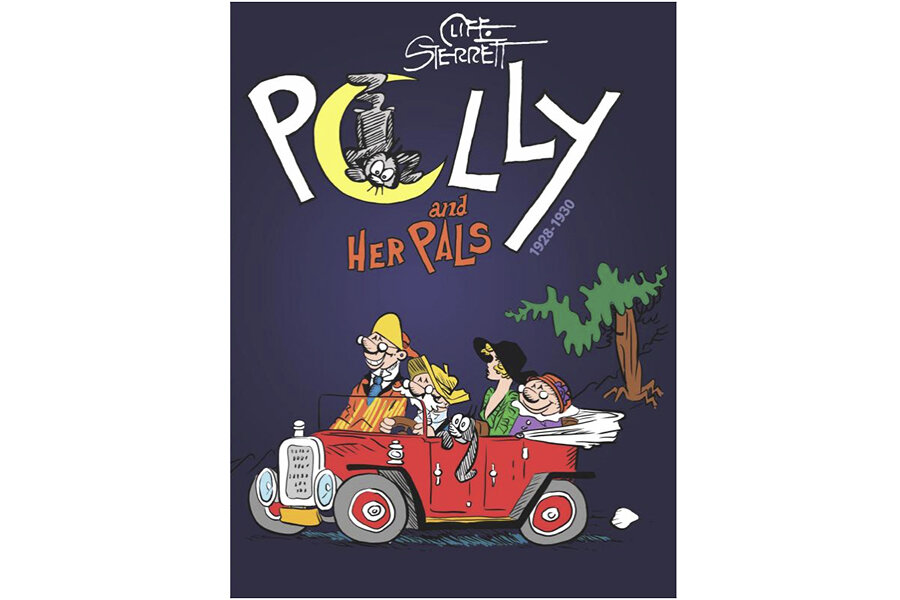'Polly and Her Pals: Volume Two,1928-1930' is a gorgeous trip to the 1920s
Loading...
You and I may have missed the Golden Age of comic strips but we are very fortunate to be here today for wonderful collections of these comics such as the newly released Polly and Her Pals, Volume Two: 1928-1930 by Cliff Sterrett from IDW Publishing’s Library of American Comics imprint. "Volume One: 1913-1927" was nominated for numerous awards and Volume Two continues this impressive series reprinting close to 150 strips, many of which have not been seen since their original Sunday comics section appearances.
Can it be that you have never heard of "Polly and Her Pals"? You would not be alone since even in its heyday the comic strip was never a huge commercial success. But it was a favorite of publisher William Randolph Hearst and the Sunday strips ran from 1913 to 1958. (The daily strip finished its run in the 1940s.). Please don't overlook this hidden treasure because you would be missing what historians have dubbed a "masterpiece of the comic art form."
Why is it a masterpiece? While on the surface it appears to be only a situation comedy, starring "pretty girl" Polly Perkins, her paw Sam, her maw Suzie, cousin Ashur, their Japanese houseboy Neewah, and house cat Kitty, later joined by Maw’s sister Carrie and her bratty daughter Gertrude. But Sterrett soon develops "Polly" into one of the most visually astounding strips ever to grace newsprint, creating dazzling patterns, warped perspectives, and surreal backgrounds, all in a colorful palette.
Influenced by art movements of his time, Sterrett worked in Art Deco, Cubism, and Surrealism styles to create eye-catching visuals. One could admire Polly without reading a line of dialogue. This is a comic strip that will inspire fine artists as well as students of comic art.
While you could just admire the visuals (many strips are actually created as wordless pantomimes) you would really miss out by not reading the dialogue. I have to admit I hesitant at first to read the strips, thinking the language and humor would be so dated that I would not get it or that it wouldn’t be funny.
I was totally wrong. This still is a very funny, endearing comic strip that holds up incredibly well, due mostly to the antics of "Paw" Perkins. He is the star of “Polly" whether he is trying to sneak by his wife, or fending off numerous suitors who call upon his daughter Polly (who like other young women in the strip is drawn in a more realistic style and adorned in the fashions of the day). Sterrett writes his dialogue with notable accents but these are easy to understand and endearing.
Since "Polly" is about a family you get to peek into the lifestyle of 1920s America. You see Polly and her family members dressing up in tux and gown to attend social events, trying to impress house guests, living with Prohibition, vacationing, and celebrating holidays. Paw is constantly trying to escape the "doldrums" of family life and in a series of continuing strips (unusual since most are single gag strips) he gets his chance. While on his way to yet another costume party, Paw, dressed as a hobo (a familiar trope of the day), is separated from his family and winds up meeting a pair of friendly hobos who take him in and show him the "carefree" life. Paw spends the next several strips having the time of his life while his family frets that he’s been kidnapped. When Paw eventually takes his new pals home giving them a taste of his "horrible" life complete with family, baths, and dinner parties, the pair run for the hills, it’s far too "tough" for them.
"Polly" could also work as a fun, insightful tool for teachers, students, or history buffs, eager to get a glimpse of everyday life in the "Roaring Twenties." But readers should be forewarned that there are also some cringe-worthy stereotypes typical of the era on display, although none are mean-spirited.
Also included are the Sunday "Topper" strips by Sterrett as well. Topper strips were shorter comics that sat on top of the main strip. The Toppers in this Volume are "Dot and Dash" and "Sweethearts and Wives," both of which highlight the broad range of Sterrett’s ability. "Dot and Dash" is about two dogs (originally a cat and dog) who get into all kinds of mischief, a real showcase for Sterrett’s talent for pantomime storytelling and his ability to create surreal, stylized art. "Sweethearts and Wives" is a witty commentary on relationships, comparing the idyllic courting stage with the "reality" of married life.
The care taken in the design of the book is the icing on the cake. The Library of American Comics label insures a quality book from the flawless reproduction of the strips to text sections that provide the background of the comics creator and creation. The text introduction in this volume includes some very rare promotional art by Sterrett.
The "Polly and Her Pals" series is made even more special by the oversized dimensions of the book. Sunday comics section comic strips were originally printed on large pages of newsprint and this book’s 12” x 16” wide "Champagne Edition" format lets us see the art in all its wonderful detail, printed on a beautiful thick white paper stock. This is how all classic Sunday comics should be collected, in all their full-sized glory. You’ll need to make some extra room on your bookshelf but it will be totally worth it. And pick up Volume One while you’re at it.





